Basically, these live subtitles turn audio dialogue and sounds into text which appears in a video, in real time. Generally, they are used at events ad gatherings which are transmitted over the Internet, or for presential meetings.
These innovative technologies evolved significantly during recent years, and today offer more precision in their capacity of transcribing from audio to text (speech to text). At present, solutions are based on machine learning techniques and voice recognition, in order to create a solution of process automation which offers subtitles for live transmission. The latter can be localized via the use of personalized dictionaries.
An interesting aspect is that, as it runs on machine learning techniques, the subtitling process provides feedback to the recognizer, in such a manner that the more emissions the automatic subtitle system generates, the more precise it will be for future emissions.
Even though they are currently not advanced enough to compare with a human professional provider of live subtitles, automatic subtitling tools continue to make progress, and can be used in meetings and events as a supplementary offer. They have several benefits as a service of live subtitles for meeting attendees, such as helping comprehension and facilitating note taking. Besides, they provide a transcription which facilitates content revision after a meeting.
Innovative technologies
Live subtitles are designed to not interfere with a meeting and can be used, for example, for events, training sessions and conference calls.
AI based automatic transcription from video to text adds value to an event. It does not only make the meeting accessible for deaf or audition impaired attendees, but also helps the attendees who know English as an additional language, and helps everyone to catch the dialogue they may have lost.
Live automatic subtitles in events can be shown on screens for everyone to see, or can be accessed through any web enabled personal device.
Inclusion of hearing impaired persons
These innovative technologies collaborate with the inclusion of hearing impaired persons. It should be highlighted that more than 5% of the world population needs rehabilitation for their hearing loss (432 million adults and 34 million children).
At a school level, live subtitles can make a difference for deaf or hearing impaired students, granting access in real time to spoken content. And for those affected by an autism spectrum disorder, for example, live subtitles reduce anxiety and provide a focal point for the delivery of information.
That is to say, automatic subtitles can make a contribution towards an inclusive meeting experience for the participants, that otherwise would not be able to listen to the speakers and event sounds. They provide access and benefit other assistants, such as those that could be distracted or non-native English speakers.
Was AI used in your company to provide automatic subtitles for events? We invite you to learn about how we generate impact on your business, solving needs and seizing opportunities that can be approached with Artificial Intelligence .


